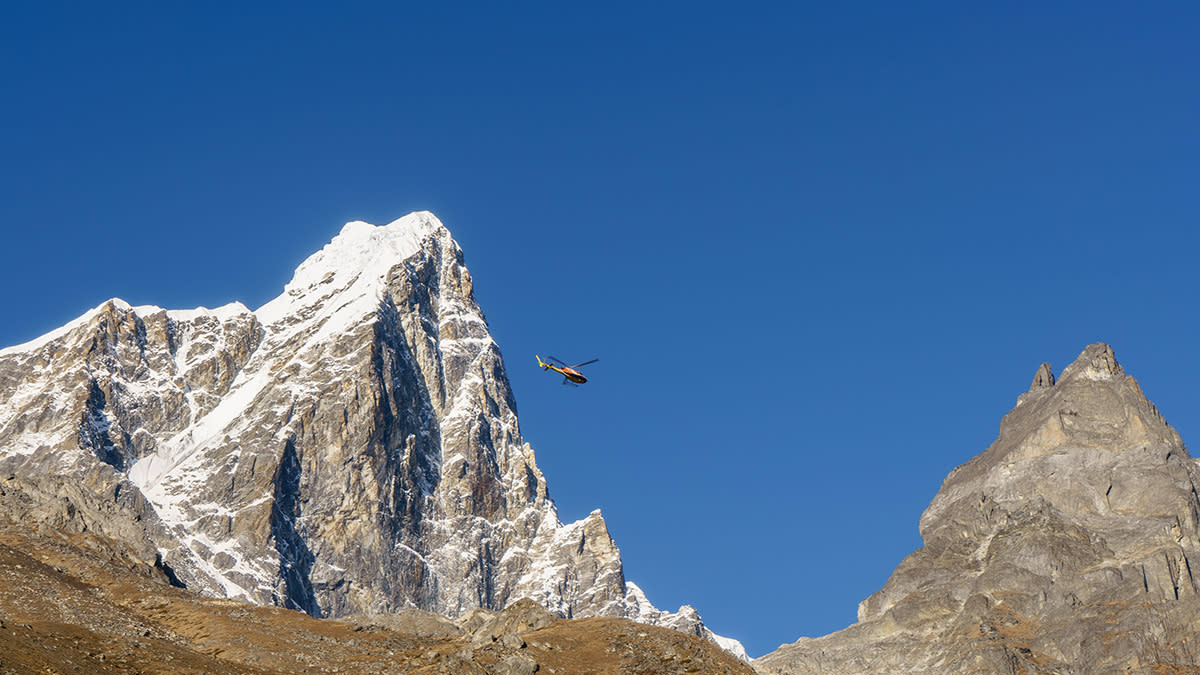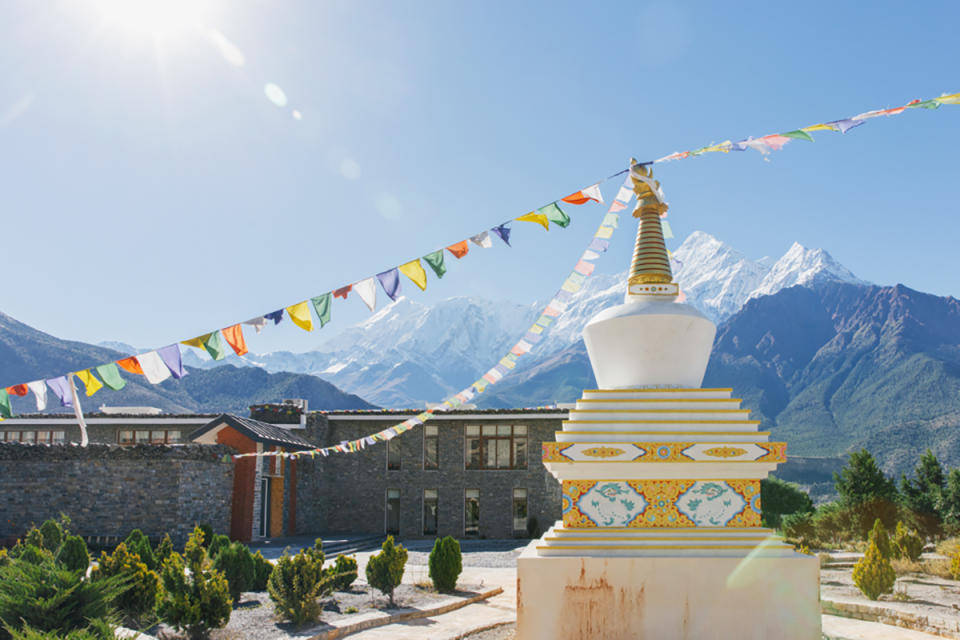How Nepal’s New Luxury Lodgings Took It From Bargain Bolthole to Jet-Set Hideaway

It wasn’t too long ago that Lonely Planet crowned Nepal as the world’s best-value destination for money-conscious travelers. The budget travel bible extolled the country’s easy access to world-famous trekking routes and underrated wildlife while keeping daily expenditures well below $50. And though a constellation of affordable guesthouses and home-stays still make it possible to trek around on a shoestring, a new generation of local tour operators and luxury lodges are increasingly catering to the deep-pocketed adventurers flocking to this corner of the Himalayas.
“Despite having always been a popular destination for affluent travelers, Nepal’s accommodation offerings haven’t been keeping pace with demand,” says Thailand-based hospitality consultant Jason Friedman. “This was particularly evident in the Everest region, where climbers spend between $60,000 and $200,00 per person, but lodging facilities have largely remained unchanged for the last three decades.”
More from Robb Report
This New Luxe Hotel Is Asia's Most Hotly Anticipated Opening of the Year. Here's a Look Inside.
This Epic Helicopter Expedition Will Take You to 8 of the World's Highest Peaks
Recognizing a gap in the market, Friedman teamed up with Nepali entrepreneur Namgyal Sherpa’s Sherpa Hospitality Group to launch Mountain Lodges of Nepal (MLN), a growing collection of luxury lodges dotting the Everest region, the Annapurna circuit, and southern Nepal’s Chitwan National Park. Each lodge comes fitted with amenities that were previously hard to consistently come by: Guests can expect down pillows and 300-thread-count bed linen, sterling service, and inspired culinary offerings drawing on local produce. By next year, MLN will be operating eight luxury lodges around the country.
“Just before the pandemic, I spotted Abercrombie & Kent’s private Boeing jet on the tarmac of Kathmandu airport,” Friedman says. “If that doesn’t indicate demand for luxury, I’m not sure what does.”

The price tag on the group’s latest outpost speaks volumes. At the Bill Bensley–designed Shinta Mani Mustang, which opened last August in northern Nepal’s remote Mustang region, rooms cost $1,800 per night, with bookings requiring a five-night minimum. It’s Nepal’s priciest lodge by a wide margin, but its amenities are equally unmatched. The 29-suite retreat, pitched up on a hillside above Jomsom town, offers its guests bespoke wellness treatments by a resident Tibetan healer; interiors studded with work from some of Nepal’s most renowned artists and artisans; and a restaurant serving up fine-dining takes on regional cuisine.
Meanwhile, the suites, with floor-to-ceiling windows framing views of the snow-capped Nilgiri mountain, come furnished with yak fur, Tibetan antiques, and bespoke cashmere throws by Altai-Himalaya, a Kathmandu-based weaving mill that counts Hermès as its largest client. The lodge is a basecamp for guided expeditions around the Mustang region, which the Shinta Mani team elevates with gourmet picnic lunches and pop-up cocktail bars on unique locations such as the banks of a glacier lake or the rooftop of a centuries-old traditional mud dwelling.
In the coming years, MLN plans to open a series of additional lodges around the Mustang region, which will take over locations that were previously earmarked as part of an Aman circuit that never came to fruition.
“The idea is to leverage Mustang’s unique diversity of landscapes and cultures into a luxury lodge circuit, akin to what Aman has achieved with its five lodges around Bhutan,” Friedman says. “This way, we don’t only create high-value jobs in locations where they don’t yet exist, we also provide access for a whole new demographic of people who never thought that they could comfortably and safely travel around these parts of the world.”

Elsewhere in the country, Kathmandu-based luxury tour operator Beyul Experiences has seen an increase in demand for trips beyond the well-trampled tourist trails.
“We’ve received more requests for itineraries with a focus on spirituality and local communities,” says founder Ang Tshering Sherpa, who has organized trips for the likes of Richard Gere and Sir Don McCullin. With its roving Beyul Camps, which pop up as well-equipped tented villages with a small army of guides, porters, chefs, and masseurs, the company opens up corners of the country where proper tourism infrastructure hasn’t yet reached. Priced from $750 per person per night (with a minimum of five nights, during which the camp will move around), Beyul can create bespoke itineraries that could include everything from helicopter expeditions to accompanying specialists—ornithologists, Buddhist scholars, yoga instructors—based on clients’ interests.
Sherpa also shares that his cash-flush clients are increasingly looking for ways to give back to communities they visit. He has orchestrated art-focused itineraries that supported the restoration of ancient temple murals and has worked on trips designed to raise funds for several health care and environmental organizations around the country.
“These have been philanthropic holidays,” he says. “The funds we have raised in philanthropic contributions has exceeded our revenue almost three-fold.”

In April this year, IHG Hotels & Resorts announced that the InterContinental brand will make its debut in Nepal with three properties planned around the country. Additionally, rumors of luxury tour operator andBeyond looking to open a Nepal outpost in the coming years are swirling around industry circles, though the company declined to comment on the matter. Mountain Lodges of Nepal, meanwhile, will debut a seasonal pop-up lodge at the Everest Base Camp during next year’s climbing season from April to May (climbing permit fees will increase from $11,000 to $15,000 per person in 2025).
“These new developments not only cater to the needs of luxury travelers but also benefit the local communities,” says Friedman. “They create high-value jobs, support local farmers and foragers, and help preserve the community’s heritage architecture and culture. In essence, it’s a win-win-win situation.”
Best of Robb Report
The Ultimate Miami Spa Guide: 15 Luxurious Places to Treat Yourself
The 7 Most Insanely Luxurious Spas in the World, From Tokyo to Iceland
17 Reasons the Caribbean Should Be at the Top of Your Travel Itinerary
Sign up for Robb Report's Newsletter. For the latest news, follow us on Facebook, Twitter, and Instagram.

